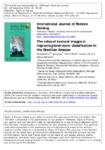Por favor, use este identificador para citar o enlazar este ítem:
http://www.alice.cnptia.embrapa.br/alice/handle/doc/1001846Registro completo de metadatos
| Campo DC | Valor | Lengua/Idioma |
|---|---|---|
| dc.contributor.author | LU, D. | pt_BR |
| dc.contributor.author | LI, G. | pt_BR |
| dc.contributor.author | MORAN, E. | pt_BR |
| dc.contributor.author | DUTRA, L. | pt_BR |
| dc.contributor.author | BATISTELLA, M. | pt_BR |
| dc.date.accessioned | 2014-12-05T11:11:11Z | pt_BR |
| dc.date.available | 2014-12-05T11:11:11Z | pt_BR |
| dc.date.created | 2014-12-05 | pt_BR |
| dc.date.issued | 2014 | pt_BR |
| dc.identifier.citation | International Journal of Remote Sensing, v. 35, n. 24, p. 8188-8207, 2014. | pt_BR |
| dc.identifier.isbn | 0143-1161 | pt_BR |
| dc.identifier.uri | http://www.alice.cnptia.embrapa.br/alice/handle/doc/1001846 | pt_BR |
| dc.description | Texture has long been recognized as valuable in improving land-cover classification, but how data from different sensors with varying spatial resolutions affect the selection of textural images is poorly understood. This research examines textural images from the Landsat Thematic Mapper (TM), ALOS (Advanced Land Observing Satellite) PALSAR (Phased Array type L-band Synthetic Aperture Radar), the SPOT (Satellite Pour l?Observation de la Terre) high-resolution geometric (HRG) instrument, and the QuickBird satellite, which have pixel sizes of 30, 12.5, 10/5, and 0.6 m, respectively, for land-cover classification in the Brazilian Amazon. GLCM (grey-level co-occurrence matrix)-based texture measures with various sizes of moving windows are used to extract textural images from the aforementioned sensor data. An index based on standard deviations and correlation coefficients is used to identify the best texture combination following separability analysis of land-cover types based on training sample plots. A maximum likelihood classifier is used to conduct the land-cover classification, and the results are evaluated using field survey data. This research shows the importance of textural images in improving land-cover classification, and the importance becomes more significant as the pixel size improved. It is also shown that texture is especially important in the case of the ALOS PALSAR and QuickBird data. Overall, textural images have less capability in distinguishing land-cover types than spectral signatures, especially for Landsat TM imagery, but incorporation of textures into radiometric data is valuable for improving landcover classification. The classification accuracy can be improved by 5.2?13.4% as the pixel size changes from 30 to 0.6 m. | pt_BR |
| dc.language.iso | eng | eng |
| dc.rights | openAccess | eng |
| dc.subject | Advanced Land Observing Satellite | pt_BR |
| dc.subject | Land-cover classification | pt_BR |
| dc.subject | Landsat Thematic Mapper | pt_BR |
| dc.subject | Phased Array type L-band Synthetic Aperture Radar | pt_BR |
| dc.title | The roles of textural images in improving land-cover classification in the Brazilian Amazon. | pt_BR |
| dc.type | Artigo de periódico | pt_BR |
| dc.date.updated | 2014-12-09T11:11:11Z | pt_BR |
| riaa.ainfo.id | 1001846 | pt_BR |
| riaa.ainfo.lastupdate | 2014-12-09 | pt_BR |
| dc.identifier.doi | 10.1080/01431161.2014.980920 | pt_BR |
| dc.contributor.institution | DENGSHENG LU, Zhejiang A&F University/Michigan State University; GUIYING LI, Michigan State University; EMILIO MORAN, Michigan State University; LUCIANO DUTRA, INPE; MATEUS BATISTELLA, CNPM. | pt_BR |
| Aparece en las colecciones: | Artigo em periódico indexado (CNPM)  | |
Ficheros en este ítem:
| Fichero | Descripción | Tamaño | Formato | |
|---|---|---|---|---|
| 4208.pdf | 2,9 MB | Adobe PDF |  Visualizar/Abrir |









